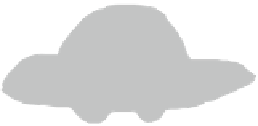Information Technology Reference
In-Depth Information
a sine curve, it will stimulate more neurons because the edge contains many
directions. We can thus expect that the illusion will become stronger if the
straight edges are replaced with slightly curved edges.
Based on these observations, we can create patterns that will give a stronger
illusion of drift than does the Ouchi pattern. An example of such a pattern is
shown in Fig.
6
.
Fig. 6.
Drift illusion “UFO in the evening glow” (Sugihara, 2013).
From this illusion, we get the next observation of the nature of the human
brain.
Observation 2.
The basic computations in the human brain are local.
4
Impossible Motion Illusion
Impossible motion is a new type of illusion evoked by a three-dimensional object.
Figure
7
shows an example of impossible motion called “magnet-like slopes”.
Panel (a) shows an object with four slopes. We initially perceive that the four
slopes each go down in a different direction from the high center. However, if
we place balls on the slopes, they appear to roll uphill toward the high center,
defying gravity, as shown in panel (b). Panel (c) shows another view of the same
situation; here, we can see that the center is the lowest point, and the balls are
just rolling downhill. Thus, the actual motion obeys gravity, but it appears to
be an impossible motion that defies physical laws.
This class of visual illusion comes from the fact that a single picture lacks
depth information, and so the human brain guesses at the most common solid
among infinitely many possibilities that are consistent with what is seen. This












































































































































































































































































































































































Search WWH ::

Custom Search